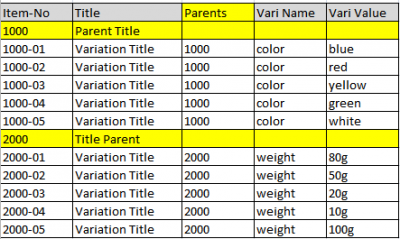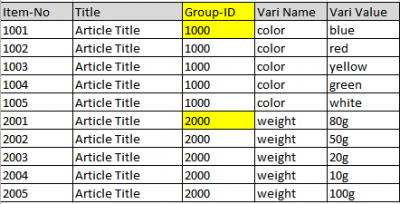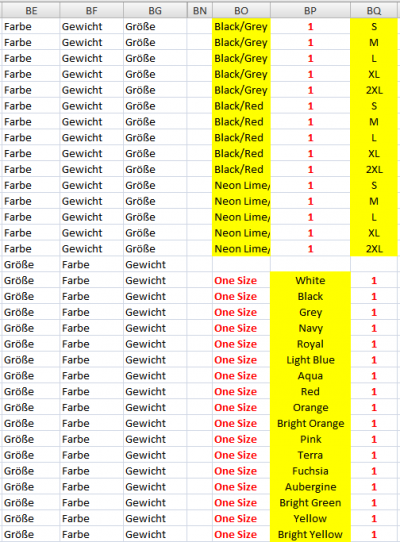Produkte Varianten/en: Unterschied zwischen den Versionen
Haemel (Diskussion | Beiträge) (Die Seite wurde neu angelegt: „== Parent-IDs with Variants ==“) |
(Übernehme Bearbeitung einer neuen Version der Quellseite) |
||
| (61 dazwischenliegende Versionen von 3 Benutzern werden nicht angezeigt) | |||
| Zeile 1: | Zeile 1: | ||
<languages/> | <languages/> | ||
| − | ''' | + | '''Variants''' can be, for example, necklaces in different lengths (cm): 1010-42, 1010-45, 1010-50 or T-shirts in different colors: 1020-red, 1020-blue and 1020-green. There are several ways to map variant products in the system. Which way you prefer depends on the structure of your records, on your procedure or even on the platform to which your data shall be transferred. |
__TOC__ | __TOC__ | ||
| Zeile 7: | Zeile 7: | ||
== Search == | == Search == | ||
| − | + | Zur Suche beachten Sie bitte unsere ausführlichen [[Produkte#Suche_und_Suchfilter|Hinweise zur Suche]] auf der Hilfeseite [[Produkte|Produkte]]. | |
| + | == Parents == | ||
| − | + | Parents can be saved as separate data records in a Data Pool: ''[ Create new Parent ]''. You can then assign any products as a variants to this parent. Once created, you can delete these parents also at any time. By the way; only the parent data record, but not the individual products will be deleted. | |
| − | + | === Example 1 === | |
| − | + | Parent as separate data record: | |
| − | |||
| − | |||
| − | Parent | ||
:'''Parent-ID''': P12345 | :'''Parent-ID''': P12345 | ||
| − | :''' | + | :'''Variants''': 12345-white, 12345-red, 12345-black, 12345-blue |
| − | : | + | :There is a 'real' separate parent data record and 4 associated variants. Thus, 5 records are stored in the Data Pool. The 4 variants have the parent ID 'P12345' in the ''Parent ID'' cell. |
| + | === Example 2 === | ||
| − | + | Import file with parents as separate data records: | |
| − | + | Parents can also be created in the Data Pool automatically using the import function. For this to work, parent records must be present in the import file. The SKU and description of these parents should (if possible) distinguish them from the variants. | |
| − | + | [[File:Parents.png||400px|Parents]] | |
| − | + | == Group-IDs == | |
| + | Group-IDs are the '''most commonly used form''' in the representation of variants. These group-IDs are not stored in separate data records, but only as an ID (a group identifier) in the data records of the associated variants. | ||
| + | Optional these Group-IDs may be converted into parents. Click on the button [Create Parent(s) NOW]. | ||
| − | == | + | === Example 1 === |
| − | + | Group-IDs: | |
| − | |||
| + | :'''Variants''': 12345-white, 12345-red, 12345-black, 12345-blue | ||
| + | :In the data pool only the 4 variants are stored. In each of the 4 variants a group-ID is stored - in this case the number 'P12345'. A 'real' parent as a separate data record does not exist. | ||
| − | === | + | === Example 2 === |
| − | + | Import file with Group-IDs: | |
| − | : | + | [[File:Group-IDs.png||400px|Group-IDs]] |
| − | |||
| + | Please, always use the import function, if you want to create a larger number of variant products. | ||
| − | == | + | == Variants' Particularities == |
| − | |||
| − | + | === Filter Variants === | |
| − | + | The following illustration is intended to represent two products with different variations. The attribute ''weight'' has a value of '1' for all items. The value for ''size'' in the lower part is for all variants 'One Size'. Strictly speaking, these values are no attributes for variations. So, what to do when you want to export in the upper part only color or size and in the lower part only the color as a variant? | |
| + | [[File:FilterVariations.png||400px|FilterVariations]] | ||
| − | + | Nehmen wir an, die Artikel wurden bereits als Varianten mit Gruppen-ID importiert. Gehen Sie dann wie folgt vor: | |
| − | + | # Datenpool ->Produkte ->Parents ->Reiter [ Gruppen-IDs ] anklicken | |
| − | + | # Links einen Datensatz markieren und auf die Schaltfläche [ Gruppenfunktion ] klicken. Hier [ Parent(s) JETZT anlegen ] auswählen und [ Ausführen ]. | |
| − | + | # Wechseln Sie zum Reiter [ Parents ]. Dort sehen Sie den soeben angelegten Parent. | |
| − | + | # Öffnen Sie den Datensatz und ordnen Sie hier nun die Variationen zu, die Sie benötigen. Unterscheiden sich die Varianten in z.B. der ''Farbe'', wählen Sie im Auswahlmenue neben diesem Feld den Wert: 'Als Variantenwert 1 benutzen'. | |
| − | + | # Speichern Sie den Datensatz! | |
| − | |||
| − | |||
| − | + | You can also make these settings for the required properties via import. | |
| − | + | Use the following numbers (must be in the cell of the column with the desired property of the parent): | |
| − | + | : 1 = Use this as 1. variant value | |
| − | + | : 2 = Use this as 2. variant value | |
| − | + | : 3 = Use this as 3. variant value | |
| + | : 4 = Use this as 4. variant value | ||
| + | : 5 = Use this as 5. variant value | ||
| + | : 99 = Use this as 99. variant value | ||
| − | + | Example: If '''Color''' is to be used as the 1st variant value, a '''1''' must be written into the cell '''Color''' of the "Parent". | |
| + | This must be done for all parent records. Should part numbers have been changed or new numbers been added in the import file, you need to adjust (if necessary) the respective parent records. | ||
| − | === | + | === Variants for Amazon === |
| − | Parent | + | Parent IDs for Amazon must '''not''' contain the following data: |
| − | * | + | * Stock |
| − | * | + | * Price |
| − | * EAN | + | * EAN number |
| − | * | + | * Attributes |
| − | + | Notes on product attributes or characteristics: | |
| − | * | + | * For measurement unit fields such as '' Length, Width, Height, Weight '' must correct units be entered. |
| − | * | + | * In the ''Size'' field - depending on the category - only specific, by Amazon predetermined values, are allowed |
| − | * | + | * In certain fields - mostly with the additional designation ''...Name'' (for example, ''SizeName'') - your own values can be used. These values must be created previously in the system. |
| − | * | + | * Product attributes ''parent'' and ''child'' must always be in lowercase. |
| + | * Based on the selected product category on Amazon, required/allowed product attributes vary. | ||
[[Category:Data Pool]] | [[Category:Data Pool]] | ||
Aktuelle Version vom 9. Juni 2019, 10:08 Uhr
Variants can be, for example, necklaces in different lengths (cm): 1010-42, 1010-45, 1010-50 or T-shirts in different colors: 1020-red, 1020-blue and 1020-green. There are several ways to map variant products in the system. Which way you prefer depends on the structure of your records, on your procedure or even on the platform to which your data shall be transferred.
Inhaltsverzeichnis
Search
Zur Suche beachten Sie bitte unsere ausführlichen Hinweise zur Suche auf der Hilfeseite Produkte.
Parents
Parents can be saved as separate data records in a Data Pool: [ Create new Parent ]. You can then assign any products as a variants to this parent. Once created, you can delete these parents also at any time. By the way; only the parent data record, but not the individual products will be deleted.
Example 1
Parent as separate data record:
- Parent-ID: P12345
- Variants: 12345-white, 12345-red, 12345-black, 12345-blue
- There is a 'real' separate parent data record and 4 associated variants. Thus, 5 records are stored in the Data Pool. The 4 variants have the parent ID 'P12345' in the Parent ID cell.
Example 2
Import file with parents as separate data records:
Parents can also be created in the Data Pool automatically using the import function. For this to work, parent records must be present in the import file. The SKU and description of these parents should (if possible) distinguish them from the variants.
Group-IDs
Group-IDs are the most commonly used form in the representation of variants. These group-IDs are not stored in separate data records, but only as an ID (a group identifier) in the data records of the associated variants. Optional these Group-IDs may be converted into parents. Click on the button [Create Parent(s) NOW].
Example 1
Group-IDs:
- Variants: 12345-white, 12345-red, 12345-black, 12345-blue
- In the data pool only the 4 variants are stored. In each of the 4 variants a group-ID is stored - in this case the number 'P12345'. A 'real' parent as a separate data record does not exist.
Example 2
Import file with Group-IDs:
Please, always use the import function, if you want to create a larger number of variant products.
Variants' Particularities
Filter Variants
The following illustration is intended to represent two products with different variations. The attribute weight has a value of '1' for all items. The value for size in the lower part is for all variants 'One Size'. Strictly speaking, these values are no attributes for variations. So, what to do when you want to export in the upper part only color or size and in the lower part only the color as a variant?
Nehmen wir an, die Artikel wurden bereits als Varianten mit Gruppen-ID importiert. Gehen Sie dann wie folgt vor:
- Datenpool ->Produkte ->Parents ->Reiter [ Gruppen-IDs ] anklicken
- Links einen Datensatz markieren und auf die Schaltfläche [ Gruppenfunktion ] klicken. Hier [ Parent(s) JETZT anlegen ] auswählen und [ Ausführen ].
- Wechseln Sie zum Reiter [ Parents ]. Dort sehen Sie den soeben angelegten Parent.
- Öffnen Sie den Datensatz und ordnen Sie hier nun die Variationen zu, die Sie benötigen. Unterscheiden sich die Varianten in z.B. der Farbe, wählen Sie im Auswahlmenue neben diesem Feld den Wert: 'Als Variantenwert 1 benutzen'.
- Speichern Sie den Datensatz!
You can also make these settings for the required properties via import. Use the following numbers (must be in the cell of the column with the desired property of the parent):
- 1 = Use this as 1. variant value
- 2 = Use this as 2. variant value
- 3 = Use this as 3. variant value
- 4 = Use this as 4. variant value
- 5 = Use this as 5. variant value
- 99 = Use this as 99. variant value
Example: If Color is to be used as the 1st variant value, a 1 must be written into the cell Color of the "Parent".
This must be done for all parent records. Should part numbers have been changed or new numbers been added in the import file, you need to adjust (if necessary) the respective parent records.
Variants for Amazon
Parent IDs for Amazon must not contain the following data:
- Stock
- Price
- EAN number
- Attributes
Notes on product attributes or characteristics:
- For measurement unit fields such as Length, Width, Height, Weight must correct units be entered.
- In the Size field - depending on the category - only specific, by Amazon predetermined values, are allowed
- In certain fields - mostly with the additional designation ...Name (for example, SizeName) - your own values can be used. These values must be created previously in the system.
- Product attributes parent and child must always be in lowercase.
- Based on the selected product category on Amazon, required/allowed product attributes vary.


